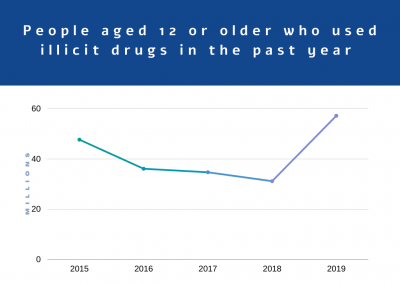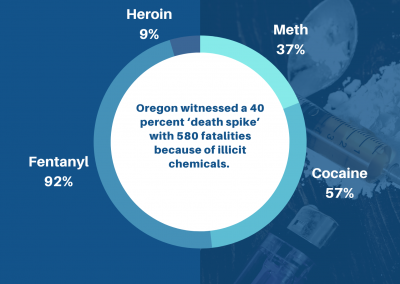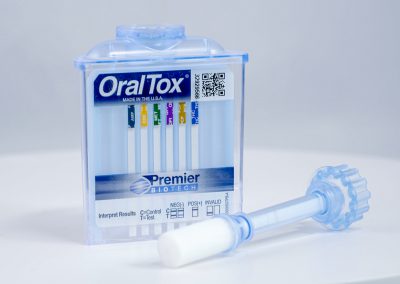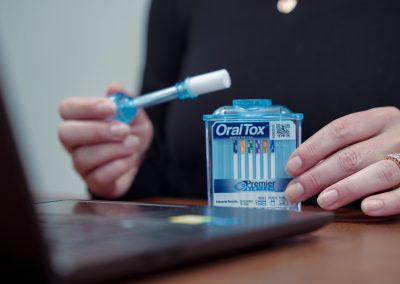The Future of Drug Testing: Oral Fluid Testing and the Importance of a Rapid Result

By Bill Current – President and Founder of the Current Consulting Group

The legalization of marijuana coupled with the devasting impact of the COVID-19 pandemic have led to an overall increase in substance abuse, more positive drug tests in the workplace, and a rise in marijuana-related traffic accidents and fatalities.
The need for drug testing, particularly a rapid-result test that is easy to collect and can detect recent use, has never been more critical.
Current Drug Abuse Trends
According to the federal government, substance abuse was already on the rise as 2020 began and the COVID-19 pandemic just made matters worse. The Substance Abuse and Mental Health Services Administration (SAMHSA) reported that between 2018 and 2019:
-
- “Among people aged 12 or older, the percentage who used illicit drugs in the past year increased from 17.8 percent (or 47.7 million people) in 2015 to 20.8 percent (or 57.2 million people) in 2019.
- These estimates in 2019 were higher than those in 2015 to 2018.”
The same report showed a dramatic increase in marijuana use:
-
- “Among people aged 12 or older, the percentage who were past-year marijuana users increased from 11.0 percent (or 25.8 million people) in 2002 to 17.5 percent (or 48.2 million people) in 2019.
- These estimates in 2019 were higher than those in 2002 to 2018.[i]
While we wait for SAMHSA’s 2020 report, there are indicators that the COVID-19 pandemic pushed substance abuse into hyperdrive and the result was fatal at times, especially in certain states.[ii]For instance:
-
- “Oregon witnessed a 40 percent ‘death spike’ with 580 fatalities because of illicit chemicals. Use of drugs like Meth increased 37 percent in a year in Oregon, Cocaine deaths climbed to 57 percent Fentanyl deaths contributed to a shocking 92 percent of deaths, and Heroin reached 9 percent.
- Virginia also suffered record highs for drug abuse and fatalities, with 2,035 drug overdoses in 2020, exceeding its record of 1,626 overdoses within a year’s time.
- Ohio lost 548 individuals to drug abuse in the spring of 2020, increasing in 14 years. Furthermore, the summer months of June and July lost 481 and 442 people in the state.[iii]
“We are seeing an increase in amphetamine positivity rates up 240 percent and opioid positivity rates up by more than 430 percent! The safety-sensitive industry has historically been hit particularly hard by the opioid epidemic. As a result of this pandemic, both amphetamines and opioids have surpassed cocaine in random drug testing positivity rates.” – Bill Current, Current Consulting Group
The Need for Drug Testing
The ongoing increase in substance abuse, alone, would justify a company’s decision to conduct drug testing; however, there are many other valid reasons, including:
-
- Drug abusers are less safe and more costly than their non-using co-workers. Reportedly, 65 percent of on-the-job accidents are due to drug and alcohol abuse.[i]Additionally, 38 to 50 percent of all workers’ compensation claims are related to drug and alcohol abuse.[ii]Workers with substance abuse disorders miss two more weeks annually than their peers, averaging nearly 25 days of missed work per year.[iii]Drug users are dangerous, expensive and result in $200 billion in lost productivity annually.[iv]
- Drug users hate drug testing. In a survey conducted by the federal government, 40 percent of full-time workers who admitted to being current illicit drug users said they were less likely to work for a company that conducted random drug testing. Additionally, 30 percent said they were less likely to work for a company that conducted pre-employment drug testing.[v]
- Employers are still legally responsible for what their employees do while on the job. The legalization of marijuana has not suspended negligent hiring and respondeat superior laws that hold employers legally liable for accidents, property damage, fatalities, theft, fraud and other bad acts caused by or committed by employees. If an employee is driving a vehicle to make a work-related delivery while high on marijuana, for example, and causes an accident, the employer will be legally responsible for property damages and any harm caused to others. Legal marijuana is no defense for the employer who could’ve known if an employee was a safety risk by conducting pre- and/or post-hire drug testing.
With the need for drug testing greater than ever before, employers need the choice of a testing method that makes testing more convenient and user-friendly, especially in legal marijuana states. While lab-based urine testing used to be the only option available, it has never met all employer needs and this especially true in today’s more challenging and litigious workplace environment. Because of advances in the science and technology of oral fluid testing, especially as a point-of-collection (POCT), rapid-result test, employers have access to a viable alternative to urine testing that makes drug testing much more accessible and easier to conduct.
Oral fluid testing is also endorsed by the federal government. In October 2019, the Substance Abuse and Mental Health Services Administration (SAMHSA) issued guidelines for oral fluid testing, often referred to by the acronym OFMG, in federal workplaces. In doing so, SAMHSA listed several advantages of oral fluid testing that apply to rapid oral fluid testing, including fast, easy-to-conduct, 100-percent observed collections, virtual elimination of drug test cheating, and the ability to detect drug use within minutes after a drug has been absorbed into the body.
Following are other advantages of oral fluid testing:
Faster and More Convenient Collections. The pandemic made urine collections much more difficult to perform as some applicants and employees refused to visit occupational health clinics where sick people gather. Oral fluid drug testing, with its donor-driven collection process, made it possible for employers to continue drug testing while eliminating the hassles inherent with typical urine collections.
Oral fluid collections, which can take place anywhere and at any time, do not require the services of a professional technician as employees or supervisors can be trained to oversee the entire collection process. Employers save the time and expense of sending individuals to off-site facilities, which can take an average of 2-4 hours. Additionally, on-site rapid-result oral fluid testing eliminates the “no-show” rate that some companies experience when sending job applicants to off-site facilities, which can be as high as 40 percent.
Oral fluid rapid-result tests also offer the advantage of a same-day result, often available in less than 10 minutes. This is a critically important benefit for companies that hire a lot of people on a regular basis, that conduct mass hiring events, or that simply experience a high rate of turnover.
Adulteration proof. All oral fluid collections are 100 percent observed from beginning to end. Trained employees literally monitor the entire process, which prevents a donor from trying to add something to the collection pad or into the collection vial. This makes it virtually impossible for a would-be cheater to do something to subvert the drug test process. Though drug test cheating is very common with urine testing, it is nearly impossible with oral fluid testing.
Recent-Use Detection and a Rapid Result. Unlike with urine and hair testing, drugs become detectable in oral fluid almost immediately after usage. This is because the parent drug can be detected in oral fluid rather than just a metabolite of a drug, which takes several hours to become detectable. In reasonable suspicion and post-accident testing situations, recent-use detection makes it possible for employers to link a drug test result with indicators of impairment such as poor work performance, or risky or aberrant behavior. This is particularly important in states that have legalized marijuana and require proof of impairment in addition to a positive marijuana test before employers can take adverse employment action. A rapid-result oral fluid test makes it possible for employers to know the result immediately and take appropriate action.
Flexibility. A rapid-result oral fluid test may be preferred in a pre-employment situation when an employer must make an immediate hiring decision or in a reasonable suspicion situation when an individual’s employment status depends on the test result. If a rapid result is positive, the sample can be sent to a lab for a confirmation test.
Additionally, oral fluid tests can be configured to include any number of drugs. A traditional 5-panel test (marijuana, cocaine, heroin, amphetamines, PCT), which may be preferred by some employers, can be expanded to include other drugs an employer wishes to include based on applicable drug-use trends. Oral fluid devices such as OralTox allow for the removal of THC testing strips from panels and an expanded testing panel of up to twelve different drugs strips if desired.
Oral Fluid Testing in The Age of Legal Marijuana
The legalization of marijuana either for medical or so-called “recreational” use has created confusion among some employers when it comes to their right to include marijuana in a drug test panel. The truth is drug testing for marijuana continues to be legal in all 50 states.
Currently, 18 states plus the District of Columbia have legalized recreational use of marijuana and 36 states have legalized it for medicinal use. Many legal marijuana laws include workplace-specific language that prohibits employers from discriminating against registered medical marijuana users and/or those who use marijuana legally, on their own time and away from the workplace.
However, even in states that have placed some restrictions on what employers can do with positive drug test results for marijuana, employers still have the right to prohibit employees from using marijuana at work, bringing it to the workplace, or being impaired or under the influence of marijuana while on the job.
Rapid-result oral fluid testing is ideal in legal marijuana states because it reveals recent use of marijuana and not necessarily lifestyle usage. A rapid drug test result makes it possible for employers to take immediate hiring or disciplinary action based on a legally defensible result that respects the rights of legal users of marijuana per local laws while simultaneously empowering employers to keep their workplaces, employees and customers safe from the dangerous effects of workers who are under the influence of marijuana while on the job.
As referenced earlier, another noteworthy trend is the requirement in some states for employers to prove an individual was impaired by or under the influence of marijuana at the time of the drug test before taking adverse employment action based on a positive result. Because of rapid-result oral fluid testing’s unique ability to show the presence of drugs within minutes after usage and only within the method’s tighter window of detection, it is ideal for employers who wish to combine a drug test result with other documented aberrant behavior to make a case that the person was impaired at the time of the drug test.
The Candidate’s Pre-Employment Screening Experience
Another unique advantage of rapid-result oral fluid testing is its overall positive impact on a candidate’s pre-employment screening experience. Consider the fact that once a job candidate passes through several layers of effort to get a job such as filling out applications and being interviewed, sometimes multiple times, he or she usually then has to somehow make their way to an off-site location to wait in line to void a urine sample. That process can take hours. Now imagine waiting at least 24 hours to learn the result of the test. A typical candidate either doesn’t show up at the collection site or fills out an application somewhere else where the candidate experience is less time-consuming and stressful.
With rapid-result oral fluid testing, the collection process is reduced to a relatively short period of time, does not require the candidate to travel to an off-site facility, and the result of the test is typically available in less than 10 minutes. Rapid-result testing makes it possible for an employer to make a final decision to hire an ideal candidate immediately making it possible for that person to start work the very same day.
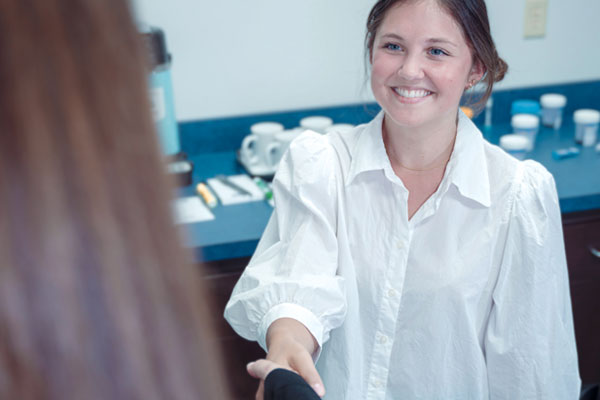
Conclusion
As one of only three drug testing methods endorsed by the federal government and the only legitimate recent-use detection method, oral fluid testing is beginning to increase its market share. Prior to the pandemic, most experts agreed that oral fluid testing probably represented about 8 percent of the drug testing market. However, as a result of the challenges employers experienced with urine collections during the COVID-19 pandemic, there are now strong indicators that oral fluid testing has increased its overall market share.
Midway through 2020, the Current Consulting Group (CCG) conducted a survey of drug testing providers in which 13 percent said they’d had clients switch to or add oral fluid testing since the start of the pandemic. In a CCG survey conducted at the end of 2020, the percentage of providers who said they’d had clients switch to or add oral fluid testing increased to 15 percent. When employers were asked the same question, 17.6 percent said they had either switched to or added oral fluid or were considering doing so.
For some companies, it may not come down to using just one drug testing method to the exclusion of all the others. However, for many companies, rapid-result oral fluid testing is an ideal match for pre-employment testing and it works well when employers must know immediately if someone had drugs in their system following an accident or when substance abuse is suspected.
Finally, another reason for the trend that is seeing oral fluid testing increase its market share is that rapid-result oral fluid testing is relatively easy to conduct anytime, anywhere, which can significantly impact the return on investment from drug testing in a very positive way. When collection times are reduced from 2-4 hours to less than 10 minutes with an on-site oral fluid test, the true cost of a drug test is demonstrably reduced.
© 2010-2021 The Current Consulting Group, LLC – No portion of this article may be reproduced, retransmitted, posted on a website, or used in any manner without the written consent of the Current Consulting Group, LLC. When permission is granted to reproduce this article in any way, full attribution to the author and copyright holder is required.
This information is provided for educational purposes only. Reader retains full responsibility for the use of the information contained herein.
[ii] LaNeve, Nicole. “Survey Shows Drug & Alcohol Use Increase During COVID-19 Pandemic.” The Recovery Village Drug and Alcohol Rehab, The Recovery Village Drug and Alcohol Rehab, 17 Dec. 2020, www.therecoveryvillage.com/drug-addiction/news/drug-alcohol-use-rising-during-covid/.
[iii] Murray, Krystina. “The Deadliest Year In Drug History.” Addiction Center. January 2021. https://www.addictioncenter.com/news/2021/01/2020-deadliest-year-drug-history/
[iv] “The COVID-19 Pandemic Leads to Surge in Drug Test Positivity Rates.” DISA. June 18, 2020. https://disa.com/news/the-covid-19-pandemic-leads-to-surge-in-drug-test-positivity-rates
[v] Reilly, Joe. “Drug Testing & Safety: What’s the Connection?” Occupational Health & Safety, 1105 Media, Inc., 1 Sept. 2014, ohsonline.com/articles/2014/09/01/drug-testing-and-safety.aspx.
[vi] Id.
[vii] “Implications of Drug Use for Employers.” National Safety Council, National Safety Council, www.nsc.org/work-safety/safety-topics/drugs-at-work/substances.
[viii] Babcock, Pamela. “Former Drug Czar: Drugs in Workplace Understated Crisis.” SHRM, SHRM, 13 Nov. 2013, www.shrm.org/resourcesandtools/hr-topics/risk-management/pages/drugs-workplace-crisis.aspx.
[ix] Why Drug Testing. William F. Current. Page 34.

